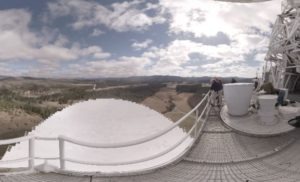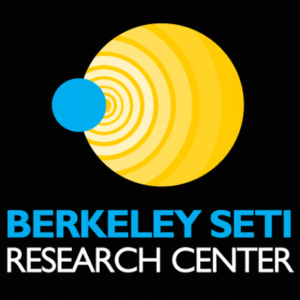[vc_row][vc_column][vc_column_text]
Shooting a 360° video requires you to abandon all that you ever knew about shooting video. No close-ups. No angles. No focal lengths.
Chris Schodt, multimedia expert & video producer, explores the nuances of 360° video during a recent shoot in a remote region of West Virginia. This past March, he ventured out to Green Bank, WV to shoot a 360° video of the Green Bank Telescope. And this structure is massive. It is sixty percent taller than the Statue of Liberty, wide enough to hold two football fields in its dish, and millions of pounds —165 to be exact. The GBT aptly, has also come to stand for the “Great Big Thing.”
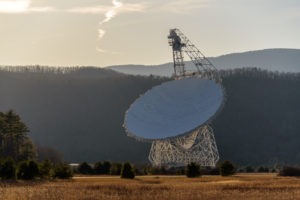 “It’s astoundingly big,” said Chris. “My thought was, ‘Hey, this is the place that needs to be shot in VR.’”
“It’s astoundingly big,” said Chris. “My thought was, ‘Hey, this is the place that needs to be shot in VR.’”
The trip ended up being a three-way collaboration between UC Berkeley Advanced Media Institute, Go-Pro (who loaned the Go-Pro Omni 360° camera for use in their first virtual reality workshop) and UC Berkeley SETI (Search for Extraterrestrial Intelligence). The trip was planned months in advance and when they actually got on site, they only had three hours to shoot the video.
Chris says a lot of VR videos show people what a place is like but that his idea was to educate people about the telescope and the people who work at the Green Bank Observatory.
He settled on having a tour guide walk around the telescope to describe its uniqueness and nuances. Since wireless mics are not permitted because the telescope lies in the US National Radio Quiet Zone, an area where radio transmissions are restricted by law due to ongoing scientific and military research; Chris had to hold the mic below the tour guide’s mouth the entire time—knowing that there’d be no way to edit himself out of the scene.
The Camera Sees Everything
“If I could do it again, I’d probably find a way to do it differently,” said Chris. “The camera sees everything. I just went with it. I tried to look for spots that were visually interesting and that had some scientific importance or even just some cool fact.”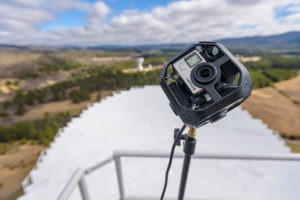
The camera sits on a narrow monopod so that it doesn’t obstruct its downward view. Chris set up the camera, and then walked away to let the camera film. He then returned to record the tour guide’s interview.
He says the biggest challenges were finding interesting shots that work in 360° and figuring out how to translate that experience into a story.
For one shot, Chris clamped the Omni to the outside of the elevator that runs up and down the telescope from roughly 120-300 feet. “That’s definitely the best shot I got,” said Chris.
Editing in 360°
Editing a 360° video is tricky and tedious. The process is called “stitching”. The editor works through a specialized software, Kolor Autopano, to take the footage from the four frames that together could hypothetically form a panoramic view and sync it with the footage from the cameras that point up and down, respectively to form a 360° sphere of video.
“It’s just an incredibly slow process,” said Chris of the process. “Any action I do, I then have to wait for like 10-20 minutes to see if it’s any good. By now, I’ve found tricks to make it a little faster but the computer does its best at auto-stitching scenes. Yet, there were big dropouts, big parts of the footage that it missed on its first attempt that I had to go back and do by hand.”
Chris laughs about how the software at times- just didn’t get it right-a headless a person appeared in a frame or worse, two halves of two head that don’t match up. During the editing phase, Chris received word of an update to the Kolor software that proved to be of value to the editing process.
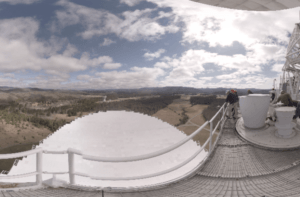
He shared with us an example: the image on the left shows a split in the railing and sensor (teacup like thing). Now compare it to the image on the right with smooth lines.
So, what exactly is the story?
“It’s not a narrative in a traditional sense,” says Chris. “It’s important to science. The largest moveable structure on earth is in West Virginia. It’s really an astounding piece of engineering. The video is more experiential than narrative but my hope is just to at least make people go, ‘Wow! This thing is really amazing.’”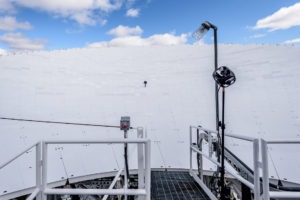
“I think 360° videos allow us to transport people to a location- a place they may never get to see or experience in person” said Chris. “It really is about that experiential thing—places that are visually amazing where people don’t understand what a place is like or where people are unlikely to be able to go.” He mused about the idea of taking a 360° camera to the international space station or placing a camera in the middle of a stage for a dance performance with people moving around and through the scene.
Chris says he is also adding in graphics to direct the viewer to the important scenes and provide context-with the hope that the viewer will not miss key elements, but still feel free to look around as if having that in-person experience.
Take your own 360° tour the GBT. Or for more visit the Berkeley SETI Research Center YouTube Channel.
A special thanks go out to all the people and organizations whose support made this video possible.
Breakthrough Listen
To experience the art of shooting, editing and producing a 360° video,
join us for the Berkeley AMI workshop:
VR: Immersive Video Storytelling on June 26-29, 2017.
[/vc_column_text][/vc_column][/vc_row]

